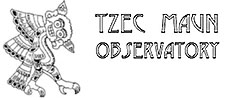Citations of the named Minor Planets, sorted by date of publication:
———————published in MPC 65714:
(207901) Tzecmaun = 2008 US91
Discovered 2008 Oct. 28 by E. Schwab at Tzec Maun.
The Tzec Maun Foundation provides free access to remote-controlled
telescopes. Pronounced „Teh-Zeck-Moan“, the name is one of the
words used by the ancient Mayan people for the planet Mercury. This is the
first minor planet discovered at an observatory of the Tzec Maun Foundation to
be numbered.
———————published in MPC 67220:
(216433) Milianleo = 2009 DM3
Discovered 2009 Feb. 19 by E. Schwab at Tzec Maun.
Milian Leo Schwab (b. 2004) is the first-born son of the discoverer.
———————published in MPC 71353:
(241418) Darmstadt = 2008 UX201
Discovered 2008 Oct. 31 by E. Schwab at the Tzec Maun Observatory, Mayhill.
Darmstadt is a German city known for its architecture of the Jugendstil
period. It is the location of the European Space Operations Centre and the
Helmholtzzentrum für Schwerionenforschung, where the chemical elements with
atomic numbers 107–112, including darmstadtium, were discovered.
———————published in MPC 72203:
(243536) Mannheim = 2010 EQ111
Discovered 2010 Mar. 15 by E. Schwab at the Tzec Maun Observatory, Moorook.
Mannheim is a German city in the federal state of Baden-Württemberg,
where Karl Benz appeared on the streets with his first car in 1886. The
Mannheim Observatory, which was in operation from 1772 to 1880, was visited by
well-known people, such as Wolfgang Amadeus Mozart and Benjamin Franklin.
———————published in MPC 75354:
(263932) Speyer = 2009 HY44
Discovered 2009 Apr. 22 by E. Schwab at the Tzec Maun Observatory, Mayhill.
Speyer is one of Germany’s oldest cities, founded by the Romans in 10 BC.
The city is dominated by the cathedral, which is the world’s largest
Romanesque church and a world heritage site.
———————published in MPC 78272:
(264020) Stuttgart = 2009 QS1
Discovered 2009 Aug. 17 by E. Schwab at the Tzec Maun Observatory, Mayhill.
Stuttgart is the capital city of the German federal state of
Baden-Württemberg. The Stuttgart Observatory, operated by the association
Schwäbische Sternwarte, and the Carl Zeiss Planetarium are heavily involved
in astronomical public education.
———————published in MPC 80329:
(301061) Egelsbach = 2008 UO91
Discovered 2008 Oct. 28 by E. Schwab at the Tzec Maun Observatory, Mayhill.
Egelsbach is a German city located between Frankfurt am Main and
Darmstadt, first mentioned in 1275. It is the home of the discoverer, from
where he detected this minor planet using a remote-controlled telescope at
Mayhill, NM.
———————published in MPC 81071:
(316042) Tilofranz = 2009 HP2
Discovered 2009 Apr. 19 by E. Schwab at the Tzec Maun Observatory, Mayhill.
Tilo Franz Schwab (b. 2008) is the second-born son of the discoverer.
———————published in MPC 81071:
(325558) Guyane = 2009 SP101
Discovered 2009 Sept. 24 by E. Schwab at the Tzec Maun Observatory, Mayhill.
Guyane is the official name for French Guiana, an overseas region of
France on the North Atlantic coast of South America. It is the location of
the Centre Spatial Guyanais (Guiana Space Centre), the European Space Agency’s
launch site.
———————published in MPC 84384:
(336698) Melbourne = 2010 CJ
Discovered 2010 Feb. 5 by E. Schwab at Tzec Maun.
Melbourne is the capital city of the Australian state of Victoria. The
Melbourne Observatory, which was in operation from 1863 to 1944, once housed
the largest telescope in the world. The Royal Botanic Gardens and the
Astronomical Society of Victoria maintain this important historical
Observatory.
———————published in MPC 86717:
(328477) Eckstein = 2009 HG36
Discovered 2009 Apr. 21 by E. Schwab at Tzec Maun.
Hartmut Eckstein (b. 1954) is an experienced astrophotographer at the
Starkenburg Observatory, also known for his aesthetic landscape photography.
His works of art have been published in several illustrated books and
presented at exhibitions in Germany and Italy. Eckstein is a teacher of
mathematics and history.
———————published in MPC 86717:
(376084) Annettepeter = 2010 VW20
Discovered 2011 Nov. 3 by E. Schwab at Tzec Maun.
Annette Peter (b. 1971) is the discoverer’s wife. The discoverer thanks
her for her tireless support and patience.
———————published in MPC 88005:
(301394) Bensheim = 2009 DB31
Discovered 2009 Feb. 23 by E. Schwab at the Tzec Maun Observatory, Mayhill.
Bensheim is a German city, first mentioned in 765. It is situated in the
district of the Bergstraße, which is a traditional wine-growing region.
Medieval timber-frame houses and many other important cultural monuments
dominate the picturesque cityscape.
———————published in MPC 89836:
(378917) Stefankarge = 2008 UP91
Discovered 2008 Oct. 28 by E. Schwab at Tzec Maun.
Stefan Karge (b. 1963), an amateur astronomer since childhood, is
heavily involved in astronomical public education and is an enthusiastic
observer of active quasars. He has discovered numerous minor planets at the
Taunus Observatory of the Physikalischer Verein and at the Tzec Maun
Observatory.
———————published in MPC 90381:
(379155) Volkerheinrich = 2009 QR6
Discovered 2009 Aug. 18 by E. Schwab at Tzec Maun.
Volker Heinrich (b. 1962), an amateur astronomer since childhood, is the
chairman of the Astronomy Section of the Physikalischer Verein at Frankfurt
am Main. He is heavily involved in public astronomical education and is an
enthusiastic collector of meteorites.
———————published in MPC 103028:
(458063) Gustavomuler = 2009 YB
Discovered 2009 Dec. 21 by E. Schwab at Tzec Maun.
Gustavo Muler (b. 1967) is a Spanish amateur astronomer, born in Argentina.
He has discovered numerous minor planets at his private observatory Nazaret on
Lanzarote Island and in 2007 he confirmed the outburst of Comet 17P/Holmes. He
made follow-up observations of this minor planet.
———————published in MPC 109633:
(389293) Hasubick = 2009 KH2
Discovered 2009 May 19 by E. Schwab at Tzec Maun.
Werner Hasubick (b. 1960) is a German amateur astronomer and an enthusiastic
observer of comets. Hasubick started his astronomical work at the Buchloe
Observatory in 1977 with the observation of C/1977 R1 (Kohler). He has now
observed more than 1000 comets. |

